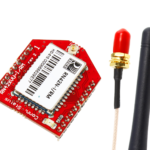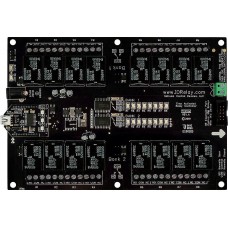Time Activated Relay 16-Channel General Purpose SPDT
Time Schedule Controlled Relay 16-Channel General Purpose SPDT
This NCD Taralist series 16-Channel relay controller allows users to control up to 16 on-board relays based on a time schedule. Taralist controllers evaluate up to 999 events each second to determine which relays should be activated or deactivated. Control signs at specific times of the day, activate security lighting, or control bells or alarms to indicate work shift or classroom changes. Taralist controllers have an on-board real time clock with battery backup to help keep the time in sync. This controller consists of 16 general purpose relays, available with your choice of 5 or 10-Amp switching current (configured during purchase). On-board LED status lights indicate relay on/off status. Take control from a computer using your favorite communication technology, including USB, RS-232, Bluetooth, WiFi, Ethernet, and industrial wireless. NCD Taralist controllers also include an on-board XR expansion port, allowing control of up to 256 relays. Mix and match relay types for different kinds of switching applications. Send commands to Taralist controllers from your computer to override the the relay control schedule or return control of the relays back to the Taralist clock. Use a computer to configure and override the relays or disconnect from your computer and let it control relays on its own. Use your computer to store multiple time schedules, simply upload a new time schedule to the controller when needed. Includes support for Daylight Savings Time and time-drift compensation. Base Station software makes it easy to configure Taralist controllers with a complete point-and-click GUI interface.
Taralist Time Activated Relay Controllers
Our Taralist Relay Controllers make it easier than ever to add time activated switching to your most demanding automation application. Taralist controllers include an integrated Real Time Clock (RTC) with battery backup that allows relays to be controlled according to a time schedule. Use your computer to sync the current time with your computer, setup the time schedule, and store your schedule into the Taralist controller. Once stored, Taralist does not require a computer for daily operation. Taralist will activate relays according to your event schedule, with a robust array of relay control events.
Time Schedule Events
Taralist stores up to 999 events into its memory. Every second, Taralist examines all 999 events and looks for a time match. When a time match is detected, a relay is turned on or off. Relays may be activated based on many time-based criteria, including: Year, Month, Day of the Month, Day of the Week, Hour, Minute, and Second. Activate relays only on Wednesdays, or only on a particular year, or both! You have tremendous flexibility in determining which matches you require for each event, making it possible to only activate relays on weekends, or on specific holidays. Some of our customers use Taralist controllers to activate a bell between classes or to control flashing signs for school zones.
Daylight Savings Time is also supported, and is fully customizable. As we all know, DST laws change periodically, but the Taralist series allow you to change the year and date of all DST events when needed (we have programmed the US DST dates until 2030 for you).
Base Station Software
Taralist controllers are configured using our Base Station Software. Base Station provides you with GUI interface for configuring events. Multiple event schedules may be saved on your computer and uploaded to Taralist when needed. Taralist controllers support most of our communications technologies. We advise having a ZUSB USB Interface module on-hand for troubleshooting, but Taralist also works through Bluetooth, WiFi, Ethernet, RS-232, and industrial wireless communication technologies.
Clock Accuracy – Adjustable Time Compensation
Clock Accuracy is of paramount importance to us. Like most clocks, time drift is a reality that must be considered. The Taralist clock has some special features to help keep the time accurate. We have included time compensation functions that allow you to automatically adjust the clock forward or back (by up to 15 seconds) each day of the week. For instance, you may find the Taralist keeps better time if it automatically advances the clock 1 second each day of the week. Or you may find that you need to subtract 5 seconds from the clock 1 day per week. Adjustable time compensation will help keep your clock accurate (though it is always a good idea to check on the clock periodically and sync it with your computer).
Computer Control
NCD time activated Relay controllers have some amazing abilities when it comes to making decisions on their own based on the events you configure, but you can take control of the relays at any time from a computer as long as your computer is connected to a Taralist controller. Send commands to override the time schedule and turn relays on or off manually with your computer. When your computer has control of the relay, Taralist will not be able to control it from your event schedule. Simple click a button to give a relay back to Taralist for time-schedule control.
Power Loss Backup Buffer
The Midnight Backup Buffer is a special feature we developed to help keep track of which relays should be activated in the event power is lost. Every night at midnight, the current status of all relays is stored in non-volatile memory. If power is lost, the Taralist will load the status of the relays from memory. Next, the Taralist will calculate all events from midnight to the current time to determine if any relays need to be activated or deactivated. Finally, the Taralist will refresh all relays and will be ready for normal operation.
Relay Outputs
NCD time activated relay controllers are capable of controlling up to 256 Relays. Taralist is available with 1, 2, 4, 8, 16, 24, 32, 48, 56, or 64 on-board relays. XR Expansion Relays may be added to the XR Expansion Port to control more relays of different types if needed.

802.15.4 Long-Range Wireless
Use 802.15.4 Communications if you require industrial strength long-range wireless communications. 802.15.4 is a point-to-point wireless standard, allowing fast communications. The wireless protocol acts as a long-distance wireless serial port, allowing wireless operation with no modification to software.

900HP-S3B Industrial Wireless Mesh
Long-Range Wireless Mesh networking is our favorite of all wireless communication technologies. This communication module will hop data from one location to another to reach its intended destination. Data hopping is a integrated feature of this communication technology, users do not need to do anything other than make sure wireless modules stay within hopping range of each other. We use the Digi 900HP-S3B module in our products, as this is the best the industry has to offer. With a 2 mile range between modules and up to 8 hops, it is possible to cover 16 miles of wireless territory using this technology. Using high-gain antennas, this module is capable of communicating to a remote module up to 28 miles away.

Bluetooth
Bluetooth is a easy way to add wireless communications to the NCD Industrial product line. The Bluetooth communications option acts as a transparent serial port between your computer and NCD devices. Simply pair the device with your computer and access the device through the COM port that is associated with the Bluetooth communications module.

Ethernet TCP/IP
Control NCD devices using standard Ethernet TCP/IP communications. Simply open a socket and send and receive TCP/IP data to control our devices. Our Ethernet TCP/IP Communication modules feature the Lantronix XPort communications module, the best in the industry. The Lantronix XPort module is an industrial workhorse that we have trusted for many years.

RS-232 Serial
NCD RS-232 Serial Communication modules make it easy to integrate the worlds most prolific communication standard. Easily interface to desktop PCs and laptops for easy control via standard serial commands. Most NCD devices typically default to 115.2K Baud; however, older low-cost devices implement 9600 baud data rate as the predominate standard.

USB
Our USB interface module makes it easy to control our devices using the USB port. Simply plug into any available USB port and start controlling our devices using standard serial commands. NCD USB Interface modules feature genuine FTDI USB to Serial Converter Chips, the very best in the industry.

WiFi TCP/IP
Control NCD devices using standard WiFi TCP/IP communications. Simply open a socket and send and receive TCP/IP data to control our devices. NCD WiFi communication modules are manufactured by Microchip, the world leader in microcontrollers.
10-Amp SPDT Relay Option
This controller is available with a 10-Amp relay option, allowing control of higher-power loads up to an absolute maximum of 240VAC at 10 Amps. Ideal for general purpose switching applications, this relays is focused on power-switching, and should never be used for low-power signals due to a higher On resistance of up to 150 Ohms when relay contacts are new (contact resistance drops to less than 1 Ohm after break-in period). The 10-Amp relay is of the SPDT variety, which provides Common (C), Normally Open (NO), and Normally Closed (NC) connections. Common is connected to NC when the relay is off. Common disconnects from NC and connects to NO when the relay is activated. All connections are made via screw terminals, capable of accepting up to 12 AWG wire.
5-Amp SPDT Relay Option
This controller is available with a 5-Amp relay option, allowing control of higher-power loads up to an absolute maximum of 240VAC at 5 Amps. Ideal for general purpose switching applications, this relays is focused on power-switching, and should never be used for low-power signals due to a higher On resistance of up to 150 Ohms when relay contacts are new (contact resistance drops to less than 1 Ohm after break-in period). The 5-Amp relay is of the SPDT variety, which provides Common (C), Normally Open (NO), and Normally Closed (NC) connections. Common is connected to NC when the relay is off. Common disconnects from NC and connects to NO when the relay is activated. All connections are made via screw terminals, capable of accepting up to 12 AWG wire.
Features
- Time Activated Relays using Integrated Real Time Clock
- Stores up to 999 Events and Control Relays Without a PC Connected
- 16 On-Board 5 or 10-Amp Relays with LED Relay Status Lights
- Battery Backed Clock Keeps Time when Powered Down
- Control Relays based on Time Schedule or Override with your PC
- Modular Communications Interface Supports Many Popular Communication Modules:
- WiFi, Bluetooth, Ethernet, Industrial Wireless, USB, RS-232 and More
- Programmable Time Compensation Reduces Time Drift
- Supports Daylight Savings Time with Programmable Schedule
- Calculates Relay Status from Midnight to the Current Time on Boot Up
- Controls 256 Relay Based on Time Schedule
- Easy GUI Configuration using Base Station Software
Enter the code in the box below:


